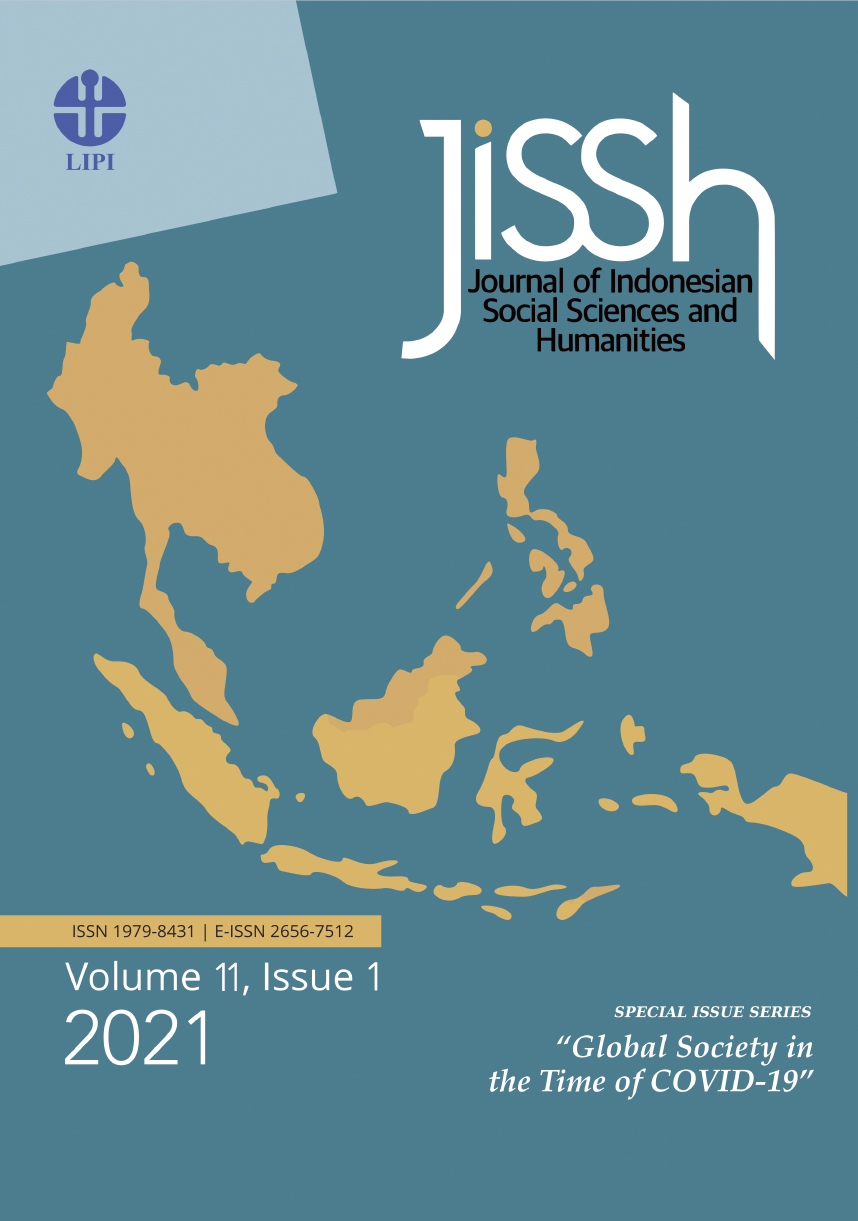Bawean Island Community Survival Strategies During The Covid-19 Pandemics
Keywords:
action, Bawean Island community, food needs, COVID-19Abstract
This study aims to examine the strategies and actions of the people of Bawean Island in meeting food needs during the COVID-19 pandemic by using Max Weber’s theory of action. Extracting information was carried out using participatory observation techniques and in-depth interviews and was supported by documentation and analysis using inductive use. The results showed that there were two strategies and actions, namely: saving on food needs and limiting household expenses. Saving on food needs is done by changing the consumption pattern of side dishes. People are looking for replacement side dishes, for example; People who are accustomed to consuming fresh sea fish for a week in a row, have started to replace them with tofu, tempeh and rencek fish. The savings were made because during the pandemic, the traffic flow from Bawean Island to Java (Gresik) was not smooth, causing foodstuffs to increase in price and scarcity. Restrictions on household expenditure are carried out by reducing household spending and only focusing on spending on food, health, electricity and fuel oil needs. These two strategies can save household food and shopping needs, before the pandemic it was usually IDR 150,000 to IDR 70,000-80,000 per day. Furthermore, the actions taken by the people of Bawean Island, namely continuing to work at the main job and working side jobs to increase income. People who choose to keep working in the main job feel that they cannot do anything other than survive in this job, this is done by many furniture traders and entrepreneurs who in the end, because there are no customers, are forced to use their savings for their daily needs. People who choose to work side by side are more based because they do not have savings funds and have to increase their income, the people who work a lot on the side in this research are the fishermen.
References
Baker, S. R., Bloom, N., Davis Steven J., J., K. K., Sammon, M. C., & Viratyosin, T. (2020). The Unprecendeted Stock Market Impact of COVID-19. NBER Working Paper Series, (26945), 1689–1699.
Bandur, A. (2017). Penelitian Kualitatif: Studi Multi-Disiplin Keilmuan Dengan Nvivo 12 Plus. Jakarta: Mitra Wacana Media.
Bodrud-Doza, M., Shammi, M., Bahlman, L., Islam, A. R. M. T., & Rahman, M. M. (2020). Psychosocial and Socio Economic Crisis in Bangladesh Due to COVID-19 Pandemic: A Perception Based Assessment. Frontiers in Public Health, 8(June). https://doi.org/10.3389/fpubh.2020.00341
Dwivedi, Y. K., Hughes, D. L., Coombs, C., Constantiou, I., Duan, Y., Edwards, J. S., … Upadhyay, N. (2020). Impact of COVID-19 pandemic on information management research and practice: Transforming education, work and life. International Journal of Information Management, 55(July), 102211. https://doi.org/10.1016/j.ijinfomgt.2020.102211
Fatchan, A. (2013). Metode Penelitian Kualitatif, Pendekatan Etnografi dan Etnometodologi Untuk Penelitian-Penelitian Ilmu- Ilmu Sosial. Yogyakarta: Ombak.
Huang, C., Wang, Y., Li, X., Ren, L., Zhao, J., Hu, Y., … Cao, B. (2020). Clinical features of patients infected with 2019 novel coronavirus in Wuhan, China. The Lancet, 395(10223), 497–506. https://doi.org/10.1016/S0140-6736(20)30183-5
Huynh, T. L. D. (2020). The COVID-19 risk perception: A survey on socioeconomics and media attention. Economics Bulletin, 40(1), 1–8.
Li, S., Wang, Y., Xue, J., Zhao, N., & Zhu, T. (2020). The impact of COVID-19 epidemic declaration on psychological consequences: A study on active weibo users. International Journal of Environmental Research and Public Health, 17(6). https://doi.org/10.3390/ijerph17062032
Lincoln, Y.S & Guba. (1985). Naturalistic Inquiry. Beverly Hill: CA-SAGE Publications.
Martin, A., Markhvida, M., Hallegatte, S., & Walsh, B. (2020). Socio-economic impacts of COVID-19 on household consumption and poverty. ArXiv. https://doi.org/10.1007/s41885-020-00070-3
McKibbin, W., & Fernando, R. (2020). The Global Macroeconomic Impacts of COVID-19: Seven Scenarios. Asian Economic Papers, 1–55. https://doi.org/10.1162/asep_a_00796
Miles, M.B., & Huberman, A.M. (1994). Analisa Data Kualitatif. Jakarta: UI Press.
Moleong, L.J. (2009). Metodologi Penelitian Kualitatif. Bandung: Rosda.
Nicola, M., Alsafi, Z., Sohrabi, C., Kerwan, A., Al-Jabir, A., Iosifidis, C., … Agha, R. (2020). The socio-economic implications of the coronavirus pandemic (COVID-19): A review. International Journal of Surgery, 78(April), 185–193. https://doi.org/10.1016/j.ijsu.2020.04.018
Poudel, K., & Subedi, P. (2020). Impact of COVID-19 pandemic on socioeconomic and mental health aspects in Nepal. International Journal of Social Psychiatry, 66(8), 748–755. https://doi.org/10.1177/0020764020942247
Ritzer, G., & Goodman, D.J. (2012). Teori Sosiologi Modern, Ed. Ke-6, (translation: Alimanda). Jakarta: Prenada Media Group
Subadi, T. (2014). Boro: Mobilitas Penduduk Masyarakat Tegalombo Sragen (Doctoral dissertation, Universitas Airlangga).
Verma, A. K., & Prakash, S. (2020). Impact of COVID-19 on environment and society. Journal of Global Biosciences, 9(5), 7352–7363. Retrieved from https://www.mutagens.co.in/jgb/vol.09/05/090506.pdf
Wyplosz, C. (2020). 14 The good thing about coronavirus, In Economics in the Time of COVID-19. Retrieved from www.cepr.org
Downloads
Published
Issue
Section
License

This work is licensed under a Creative Commons Attribution-ShareAlike 4.0 International License.
Authors who publish with this journal agree to the following terms:
1. Authors retain copyright and grant the journal right of first publication with the work simultaneously licensed under an Attribution-ShareAlike 4.0 International (CC BY-SA 4.0) license. This license allows others to remix, adapt, and build upon the work, as long as they credit the author and license their new creations under the same terms.
2. Authors may enter into separate, additional contractual arrangements for the non-exclusive distribution of the journal’s published version of the work (e.g., posting it to an institutional repository or including it in a book), provided there is an acknowledgment of its initial publication in this journal.
3. Authors are permitted and encouraged to post their work online (e.g., in institutional repositories or on their personal website) prior to and during the submission process, as this can lead to productive exchanges and increase citations of the published work (See The Effect of Open Access ).


















